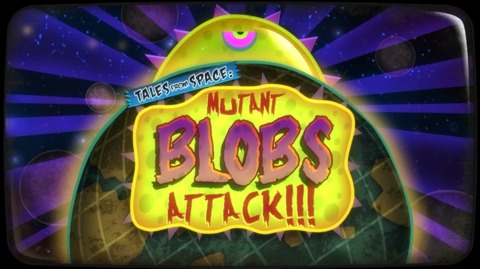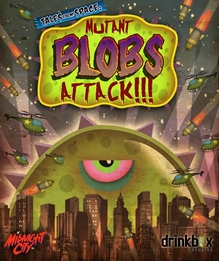Tales from Space: Mutant Blobs Attack

The zeerust-tastic Tales from Space: Mutant Blobs Attack has a couple of pertinent facts to disclose: the first is that it is the sequel to the equally 1950s sci-fi heavy Tales from Space: About a Blob (which fans of this site will remember for its memorable Ryan and Vinny Quick Look) and it was one of the 2012 games to be part of the launch library of the PS Vita. But all its history doesn't matter so much as the fact that it's an excellent puzzle-platformer that I'm enjoying very much.
Both Blob games share a lot of similarities. The player is the eponymous blob of the title; a ravenous gelatinous creature with an exceptionally dim view of mankind, which it first sees as an obstacle to be avoided and eventually as food to be eaten. With nary a Steve McQueen in sight to stop them, the blobs move through each stage absorbing any and all edible matter and increasing their mass, using a similar size-gated progression seen in the Katamari Damacy games. Mutant Blobs Attack's annoyed amorphous anti-hero also has a few other tricks up its contractile vacuole (I looked that one up! I think it's the amoeba's butthole!): it can cling to or repel itself from metallic objects with innate magnetism, and it can use telekinesis to push and pull certain objects in the vicinity. Along with its intrinsic shapelessness and a downward stomp, it's a versatile character and the game isn't lacking for ideas to challenge the player with the number of abilities on offer. It can make it a bit hectic to remember what all the buttons do, but even playing on keyboard I've been able to adjust.

Not enough good things can be said about how it controls either. Despite being a slippery customer, the blob is easy to manage because every point of contact between itself and the ground counts as "standing", allowing the player to clip the edge of a platform and still correct their way on top of it either by pushing hard enough or jumping again. Decent air control, a workable if limited wall jump and some generous checkpointing means I rarely have a reason to grouse about a sudden death. There is certainly a few cases where the control is taken away from you, specifically whenever you're whizzing through tubes at incredible speeds, and there's a few times when I've gotten killed a few times at the same spot and a tooltip's had to appear out of the ether to inform me that there was a heretofore unknown application of one of my powers I could use to avoid dying so much, whether that's using the stomp move to switch direction while falling down a fast-moving vertical corridor lined with spikes or using rockets to push very close to a wall. That the developers thought to give players a chance to figure it out on their own first before lending a helpful hint is actually fairly novel, and I wonder how useful such a feature would be in, say, Super Mario Maker whenever Patrick Klepek is playing it before his first cup of coffee in the morning.
It has some angular style to a lot of its artwork, which I imagine comes from a more 1960s/1970s era of graphic design of the like Saul Bass was probably known for. I'm no expert in that field, obviously, but I recall seeing it a lot in Jazzpunk too and it definitely leaves an impression. Music's odd, but it's starting to grow on me too. I could do with fewer memes, pop culture references and shout-outs for other Indie games on the background billboards, but that sort of nonsense tends to be inescapable with Indie games of a certain vintage.

In his most recent Jimquisition video, Jim Sterling considers the reasons why an inventive but flawed Indie game might get preferential treatment over an equally inventive but flawed AAA title by the critical community, and how many critics seem to prop up Indie darlings while leaving so many AAA games with half-hearted acclaim and middling scores (you know, like the audacious ignominy of a mere 8.8). He came to a few conclusions in the course of his video - Indie games take more risks, have less advertising to promote themselves effectively and thus are more attractive games to champion, and that there are a vast number of Indie games released every year and the only ones that ever get talked about tend to be the cream of the crop - but the observation most relevant when discussing Mutant Blobs Attack is how Indie games are highly rated because of their frequent emphasis on simplicity over complexity. When you set your sights on as modest a goal as creating a puzzle-platformer with an appealing aesthetic, responsive controls and enough abilities and tricks to learn to keep the game fresh for its comparatively brief four or five hour average runtime, it's hard to find fault in a game that nails each one of those targets. Maybe you could knock off points for a lack of ambition or a fundamental similarity to other Indie games in the same genre, but ultimately those are some arbitrary and unfair admonitions and I'd have no qualms recommending this game to anyone after what I've played of it so far, while I may have more reservations about an equally unconditional endorsement for The Witcher 3 simply because a game that big and ambitious is bound to have a few more faults to poke a wagging finger towards.
I'm about halfway through the game, so let's stop here and save the rest of the discussion for tomorrow. Until then!

(All right, so y'all may be wondering about Burnstar. You might recall yesterday that I was being sort of wishy-washy about whether I liked it or not; but the truth is there was something about the game that was bugging me and in my tired state last night I wasn't quite able to put a finger on what that was until I resumed playing it again today: it has no way to reverse mistakes except via a full restart of the level. This started becoming a problem when stages became larger and required that I place a dozen bombs and rockets in ideal spots to maximize the output of stars, all the while avoiding getting clobbered by some random stage hazard. Mess up once, and it's right back to the beginning. None of the courses are actually all that long - the time limit goal is usually around a minute to 90 seconds - but there were times where I'd spend three minutes setting up everything perfectly and dying on the way to the exit, and I could almost see minutes of my finite lifespan falling away from me like grains of sand in an hourglass.
My number one rule for game design is "never waste the player's time", with its player-side corollary of "stop playing a game as soon as it starts feeling like a waste of time". Again, numerous ways to interpret that (does grinding and farming count?), but it basically boils down to whether or not a game is requiring you to do something you don't want to do, such as repeat the last five or more minutes, because of some deficiency in the design. I can't imagine it would have been a huge issue to implement a reset function that would take the player back to just prior to the most recently placed explosive if the player thinks they messed up - it's not like they don't provide a grace period to recover any placed bomb, provided the player can grab it before it explodes. I can't see myself playing any more of that game, knowing what frustrations lie ahead without that necessary concession to user friendliness.)

Log in to comment